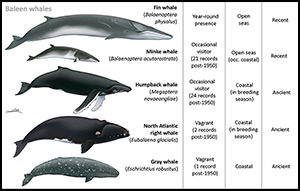Crossref Citations
This article has been cited by the following publications. This list is generated based on data provided by
Crossref.
Bernal-Casasola, Darío
Gardeisen, Armelle
Morgenstern, Peggy
Horwitz, Liora Kolska
Piqués, Gäel
Theodoropoulou, Tatiana
and
Wilkens, Barbara
2016.
Ancient whale exploitation in the Mediterranean: the archaeological record.
Antiquity,
Vol. 90,
Issue. 352,
p.
914.
Rodrigues, Ana S. L.
Charpentier, Anne
Bernal-Casasola, Darío
Gardeisen, Armelle
Nores, Carlos
Pis Millán, José Antonio
McGrath, Krista
and
Speller, Camilla F.
2018.
Forgotten Mediterranean calving grounds of grey and North Atlantic right whales: evidence from Roman archaeological records.
Proceedings of the Royal Society B: Biological Sciences,
Vol. 285,
Issue. 1882,
p.
20180961.
Pétillon, Jean-Marc
Chauvière, François-Xavier
Speller, Camilla
McGrath, Krista
Rodrigues, Ana S.L.
Charpentier, Anne
and
Baleux, François
2019.
A Gray Whale in Magdalenian Perigord. Species identification of a bone projectile point from La Madeleine (Dordogne, France) using collagen fingerprinting.
Paléo,
p.
230.
Thongcharoenchaikit, Cholawit
and
Eda, Masaki
2020.
Discriminant function analysis of atlas and axis vertebrae of the toothed whale to facilitate species identification in zooarchaeological specimens.
International Journal of Osteoarchaeology,
Vol. 30,
Issue. 6,
p.
843.
Ahlgren, Hans
Bro-Jørgensen, Maiken Hemme
Glykou, Aikaterini
Schmölcke, Ulrich
Angerbjörn, Anders
Olsen, Morten Tange
and
Lidén, Kerstin
2022.
The Baltic grey seal: A 9000-year history of presence and absence.
The Holocene,
Vol. 32,
Issue. 6,
p.
569.
Charpentier, Anne
Rodrigues, Ana S.L.
Houmard, Claire
Lefebvre, Alexandre
McGrath, Krista
Speller, Camilla
van der Sluis, Laura
Zazzo, Antoine
and
Pétillon, Jean-Marc
2022.
What's in a whale bone? Combining new analytical methods, ecology and history to shed light on ancient human-whale interactions.
Quaternary Science Reviews,
Vol. 284,
Issue. ,
p.
107470.
Dai, Yufei
Zhao, Liyuan
Wu, Fuxing
Miao, Xing
Zeng, Qianhui
and
Wang, Xianyan
2022.
Identification of cetaceans from bones using molecular techniques provides insights into cetacean species diversity and composition in coastal western Taiwan Strait waters, China.
Conservation Genetics Resources,
Vol. 15,
Issue. 1-2,
p.
1.
Buss, Danielle L.
van den Hurk, Youri
Falahati-Anbaran, Mohsen
Elliott, Deirdre
Evans, Sally
Frasier, Brenna A.
Mulville, Jacqueline A.
Rankin, Lisa K.
Stebergløkken, Heidrun
Whitridge, Peter
Barrett, James H.
and
Hart, John P.
2023.
Archaeological evidence of resource utilisation of the great whales over the past two millennia: A systematic review protocol.
PLOS ONE,
Vol. 18,
Issue. 12,
p.
e0295604.
Wellman, Hannah P.
Zhang, Hua
Yang, Dongya Y.
Evans, Zara D.
Miner, Maxwell
and
Speller, Camilla F.
2024.
Native American use of cetaceans in pre-contact Oregon: Biomolecular and taphonomic analyses illuminate human–cetacean relationships.
The Journal of Island and Coastal Archaeology,
p.
1.





